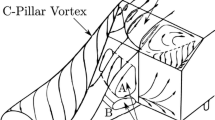Abstract
The wake of a 3D bluff body is studied in a hydrodynamic flow. The high Reynolds number (about 2×106) corresponds to the case of a full-scale road vehicle in a wind tunnel. A cavitation technique is proposed to identify the lowest pressure regions. It is found that these regions correspond to the two longitudinal vortices produced at the edges of the rear part of the vehicle. This technique also provides non-intrusive bulk measurements of the pressure minimum. It is found that the pressure coefficient of the longitudinal vortices is equal to Cp=−1.67, which underlines their strong contribution to the global drag. We show that cavitation can be a very useful technique to get three-dimensional information which is difficult to obtain through classical wind tunnel measurements.





Similar content being viewed by others
References
Ahmed SR (1983) Influence of base slant on the wake structure and drag of road vehicles. J Fluids Eng 105:429–434
Ahmed SR, Ramm R, Faltin G (1984) Some salient features of the time-averaged ground vehicle wake. SAE technical paper series 840300:1–30
Aider JL, Dubuc L, Hulin G, Elena L (2000) Experimental and numerical investigation of the flow over a simplified vehicle shape. In: Proceedings of the 3rd MIRA international vehicle aerodynamics conference, Rugby, UK
Aider JL, Elena L, Le Sant Y, Bouvier F, Mérienne MC, Peron JL (2001) Pressure sensitive paint for automotive aerodynamics. SAE paper 2001-01-0627
Ardonceau P, Amani G (1992) Remarks on the relation between lift induced drag and vortex drag. Eur J Mech B/Fluids 11(4):455–460
Blake FG (1949) The onset of cavitation in liquids. Harvard Acoustics Research Lab, technical memo no 9
Chometon F, Laurent J (1990) Study of three-dimensional separated flows, relation between induced drag and vortex drag. Eur J Mech B/Fluids 9(5):437–455
Djeridi H, Gabillet C, Billard JY (2004) Two-phase Couette-Taylor flow: Arrangement of the dispersed phase and effects on the flow structures. Phys Fluids 16(1):128–139
Drouin V, Giovannini A, Gillieron P (2002) Topology and characterization of the vortical near-wake flow over a simplified car model. In: Proceedings of the Bluff body wakes and vortex induced vibrations (BBVIV3) conference, Port-Douglas, Australia
Gillieron P, Chometon F (1999) Modeling of stationary three-dimensional separated flow around an Ahmed reference model. In: Eur Ser Appl Ind Math Proc 7:173–182
Howard RJA, Pourquie M (2002) Large eddy simulation of an Ahmed reference model. J Turbulence 3(1):12
Hucho WH, Sovran G (1993) Aerodynamics of road vehicles. Ann Rev Fluid Mech 25:485–537
Hucho WH (1998) Aerodynamics of road vehicles. Cambridge University Press
Korkut E, Atlar M (2002) On the importance of the effect of turbulence in cavitation inception tests of marine propellers. Proc Roy Soc Lond 458:29–48
Krajnović S, Davidson L (2004) Large-eddy simulation of the flow around simplified car model. SAE paper 2004-01-0227
Lienhart H, Stoots C, Becker S (2000) Flow and turbulence structures in the wake of a simplified car model (Ahmed model). In: DGLR, Fach Symp AG STAB, Stuttgart University
Lienhart H, Becker S (2003) Flow and turbulence structures in the wake of a simplified car model. SAE paper 2003-01-0656
Morel T (1978) The effect of base slant angle on the flow pattern and drag on the three-dimensional bodies with blunt ends. In: Sovran G et al (eds) Proceedings of the symposium on aerodynamics drag mechanism of Bluff bodies and road vehicles, New York, pp 191–226
Onorato M, Costelli AF, Garrone A (1984) Drag measurement through wake analysis. SAE technical paper series 840302:85–93
Plesset MS, Prosperetti A (1981) Bubble dynamics and cavitation. Annu Rev Fluid Mech 9:145
Ran B, Katz J (1994) Pressure fluctuations and their effect on cavitation inception within water jets. J Fluid Mech 262:223–263
Rood EP (1991) Review—Mechanisms of cavitation inception. J Fluids Eng 113:163–175
Shaw CT, Garry KP, Cress T (2000) Using singular system analysis to characterize the flow in the wake of a model passenger vehicle. J Wind Eng Ind Aerodyn 85:1–30
Verzicco R, Fatica M, Iaccarino G, Moin P, Khalighi B (2002) Large eddy simulation of a road vehicle with drag-reduction devices. Am Inst Aeronaut Astronaut J 40(12):2447–2455
Acknowledgements
This work benefited from the financial support of Région Haute-Normandie, France.
Author information
Authors and Affiliations
Corresponding author
Rights and permissions
About this article
Cite this article
Beaudoin, J.F., Cadot, O., Aider, J.L. et al. Cavitation as a complementary tool for automotive aerodynamics. Exp Fluids 37, 763–768 (2004). https://doi.org/10.1007/s00348-004-0879-y
Received:
Accepted:
Published:
Issue Date:
DOI: https://doi.org/10.1007/s00348-004-0879-y



